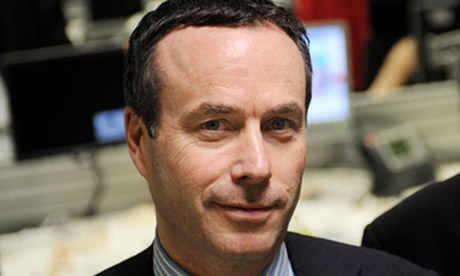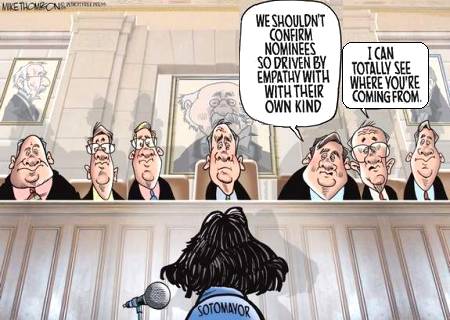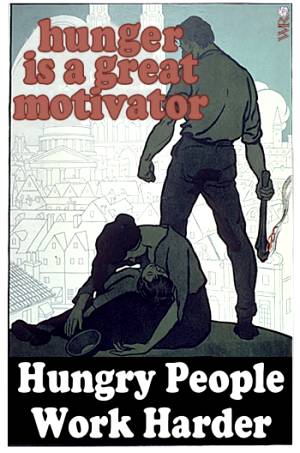Have you ever noticed how difficult it is for today's conservatives to be intentionally funny? Oh, sure, they can make you fall down laughing when they're dead serious about things but when it comes to honest-to-God observational humor? Their sense of "righteousness" gets in the way, their paranoia, their blinders-impaired worldview. It's tough to be intentionally funny when your basic premise is: you're either with me or with the enemy.
Good observational humor comes from the concept that the world is crazy but we can all be in on the joke. It not only speaks truth to power, but also tosses a banana cream pie at it for good measure.
Here's comedian Bill Hicks commenting on the rationale behind the first Iraq War. "People say 'Iraq had the fourth largest army in the world.' Yeah, maybe, but you know what, after the first 3 largest armies, there's a REAL big fucking drop-off. The Hare Krishnas are the 5th largest army in the world, and they've already got all our airports."
And here's Dennis Miller commenting on the current one: "Liberals should not overplay this weapons of mass destruction card, because you want me to tell you the truth? Most of us are not going to care if they don't find these weapons of mass destruction. It's enough for a lot of us to see those kids smiling on that street again."
Bill Hicks on the first war: "You know we armed Iraq. I wondered about that too, you know. During the Persian Gulf War, those intelligence reports would come out: 'Iraq: incredible weapons -- incredible weapons.' 'How do you know that?' 'Uh, well... we looked at the receipts. But as soon as that check clears, we're goin' in.'"
Dennis Miller on the current: "And finally, and most importantly, the next time we go to war, don't give a specific reason for the war that the left can seize upon and later flog us with it ad nauseam, just do it. Remember, the first rule of Fight Club is that you don't talk about Fight Club."
See the difference? (I mean, aside from the fact that Bill Hicks has been dead for fifteen years and Dennis Miller's career has been dead for less than ten.)
There's a certain clash between the conservative view and humor, in that humor is the great equalizer. Modern-day conservatism depends on the concept that there's only one way to view the world that is correct and, therefore, superior.
And, so, conservative "humorists" usually resort to fairly pre-pubescent "nyah-nyah" stuff that relies on racial and social stereotypes to swat back any belief system other than their own. When the French, for instance, refused to back Bush's Iraq invasion, Dennis Miller quipped "and after we had the good taste to chisel the armpit hair off the Statue of Liberty..."
He also tossed off the humorous, "Listen, I would call the French scum bags, but that, of course, would be a disservice to bags filled with scum."
In this realm of comedy, Italians are all cowards, the French don't bathe, the Irish are drunks, Scotsmen are thrifty, Poles are idiots and blacks are shiftless. In other words, it's second grade recess intellectualism at its finest. This type of humor shouldn't be dismissed because of PC reasons, but it should be acknowledged as being PJ - Pretty Juvenile.
Of course, conservative humorists don't see it that way. When Jackie Mason, who's gone from dwelling in the Borsht Belt to the Bile Belt in record time, referred onstage to Barack Obama as a "schvartze," he insisted he wasn't being racist and was offended that people would be offended, explaining "If it's a racist society the white people are the ones being persecuted because they have to defend themselves."
He told TMZ "Chris Rock has told a lot more jokes about whites than I have against Blacks. What about the demeaning words Blacks say about Jews?"
Yeah, remember Chris Rock's classic routines on Yids? Me, neither.
http://www.smirkingchimp.com/thread/22808


 Investigative reporter Seymour Hersh raised eyebrows back in March when he told an audience at the University of Minnesota that Dick Cheney ran a secret hit squad that he
Investigative reporter Seymour Hersh raised eyebrows back in March when he told an audience at the University of Minnesota that Dick Cheney ran a secret hit squad that he 


 In mid-May, in an effort to reach consensus, President Obama secured a deal with the health insurance companies to trim 1.5% of their costs each year for ten years saving a total of $2 trillion dollars, which would be reprogrammed into healthcare. Just two days after the announcement at the White House the insurance companies reneged on the deal which was designed to protect and increase their revenue at least 35%.
In mid-May, in an effort to reach consensus, President Obama secured a deal with the health insurance companies to trim 1.5% of their costs each year for ten years saving a total of $2 trillion dollars, which would be reprogrammed into healthcare. Just two days after the announcement at the White House the insurance companies reneged on the deal which was designed to protect and increase their revenue at least 35%.  The
The 










 Thanks to the Pentagon and a Maryland Robotics Company, the robots who inherit the Earth when humanity is wiped out will be able to survive by feasting on the flesh of human corpses!
Thanks to the Pentagon and a Maryland Robotics Company, the robots who inherit the Earth when humanity is wiped out will be able to survive by feasting on the flesh of human corpses! Up to 375,000 registered gun owners in Arizona and Tennessee were today given the right to carry concealed guns into bars and restaurants that serve alcohol, in the latest example of loosening gun laws in a country already renowned for its lax approach to firearms.
Up to 375,000 registered gun owners in Arizona and Tennessee were today given the right to carry concealed guns into bars and restaurants that serve alcohol, in the latest example of loosening gun laws in a country already renowned for its lax approach to firearms.






